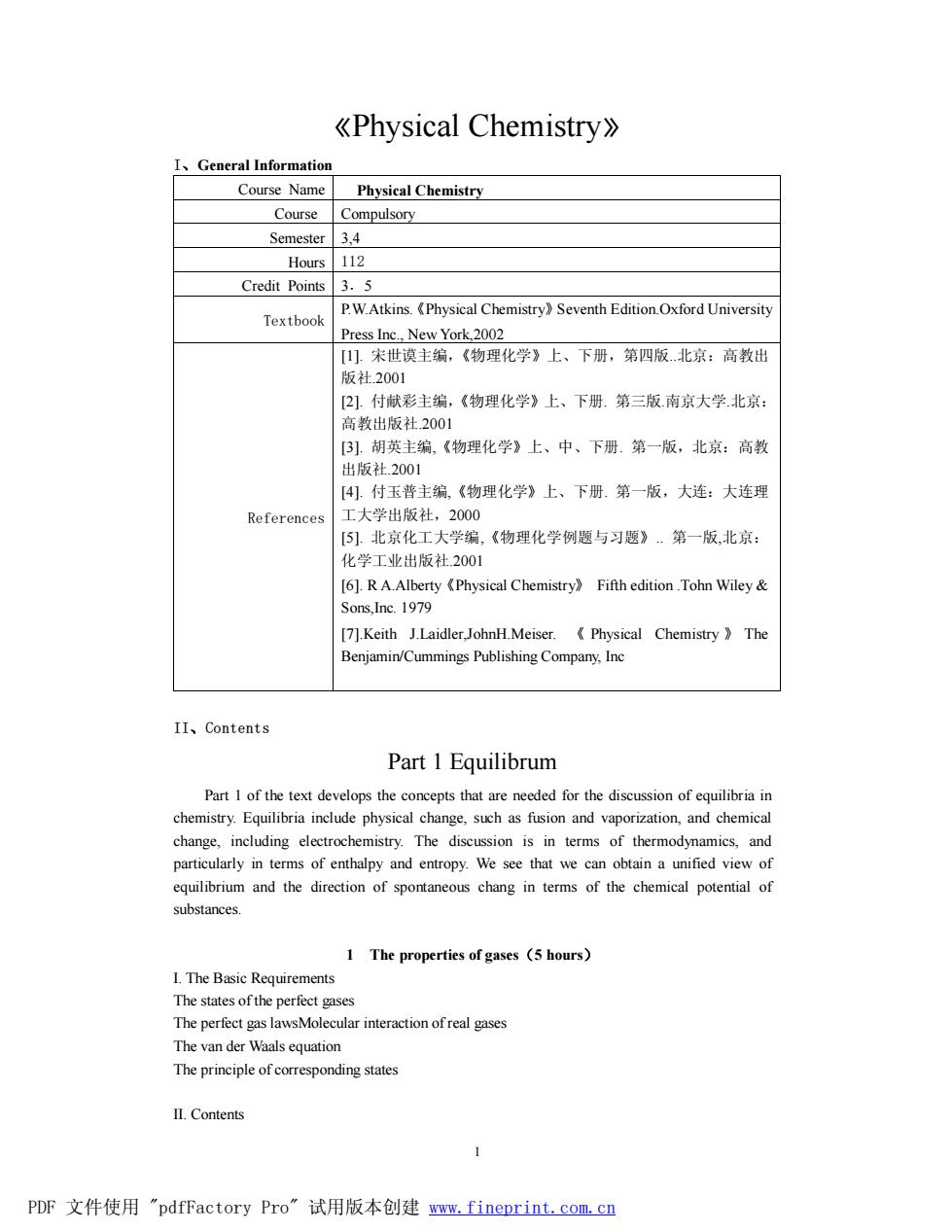
Physical Chemistry》 I,General Information Course Name Physical Chemistry Course ompulsory Semester Hours 112 Credit Points3.5 PWAtkinsPhysical Chemistry Seventh Edition.Oxford University 价宋世谟主编《物理化学》上、下所,第四版北京:高教出】 s In 002 [2】.付献彩主编,《物理化学》上、下册.第三版南京大学北京: 高教出版社.2001 [31.胡英主编,《物理化学》上、中、下册.第一版,北京:高教 出版社.2001 [4付玉普主编,《物理化学》上、下册,第一版,大连:大连理 References 大学出服补,2000 [5北京化工大学编,《物理化学例题与习》…第一版,北京 化学工业出版社.2001 [6].RA.Alberty (Physical Chemistry?Fifth edition.Tohn Wiley Sons Inc.1979 [7]Keith J.Laidler JohnH.Meiser.Physical Chemistry The njamin/Cummings Publishing Company,Ine II、Contents Part 1 Equilibrum istry ange ,such as fiusio nd va nd cher change,including electroc The discussion is in terms of thermodynamics,and particularly in terms of enthalpy and entropy.We see that we can obtain a unified view of equilibrium and the direction of spontaneous chang in terms of the chemical potential of substances. 1 The properties of gases (5 hours) 1.The Basic Requirements The tates of the r TieperfetgaslasMolceriniteractionofrelgascg The van der Waals equation The principle of corresponding states II.Contents PDF文件使用"pdfFactory Pro”试用版本创建,fineprint.com,cn
1 《Physical Chemistry》 I、General Information Course Name Physical Chemistry Course Compulsory Semester 3,4 Hours 112 Credit Points 3.5 Textbook P.W.Atkins.《Physical Chemistry》Seventh Edition.Oxford University Press Inc., New York,2002 References [1]. 宋世谟主编,《物理化学》上、下册,第四版..北京:高教出 版社.2001 [2]. 付献彩主编,《物理化学》上、下册. 第三版.南京大学.北京: 高教出版社.2001 [3]. 胡英主编,《物理化学》上、中、下册. 第一版,北京:高教 出版社.2001 [4]. 付玉普主编,《物理化学》上、下册. 第一版,大连:大连理 工大学出版社,2000 [5]. 北京化工大学编,《物理化学例题与习题》.. 第一版,北京: 化学工业出版社.2001 [6]. R A.Alberty《Physical Chemistry》 Fifth edition .Tohn Wiley & Sons,Inc. 1979 [7].Keith J.Laidler,JohnH.Meiser. 《 Physical Chemistry 》 The Benjamin/Cummings Publishing Company, Inc II、Contents Part 1 Equilibrum Part 1 of the text develops the concepts that are needed for the discussion of equilibria in chemistry. Equilibria include physical change, such as fusion and vaporization, and chemical change, including electrochemistry. The discussion is in terms of thermodynamics, and particularly in terms of enthalpy and entropy. We see that we can obtain a unified view of equilibrium and the direction of spontaneous chang in terms of the chemical potential of substances. 1 The properties of gases(5 hours) I. The Basic Requirements The states of the perfect gases The perfect gas lawsMolecular interaction of real gases The van der Waals equation The principle of corresponding states II. Contents PDF 文件使用 "pdfFactory Pro" 试用版本创建 www.fineprint.com.cn
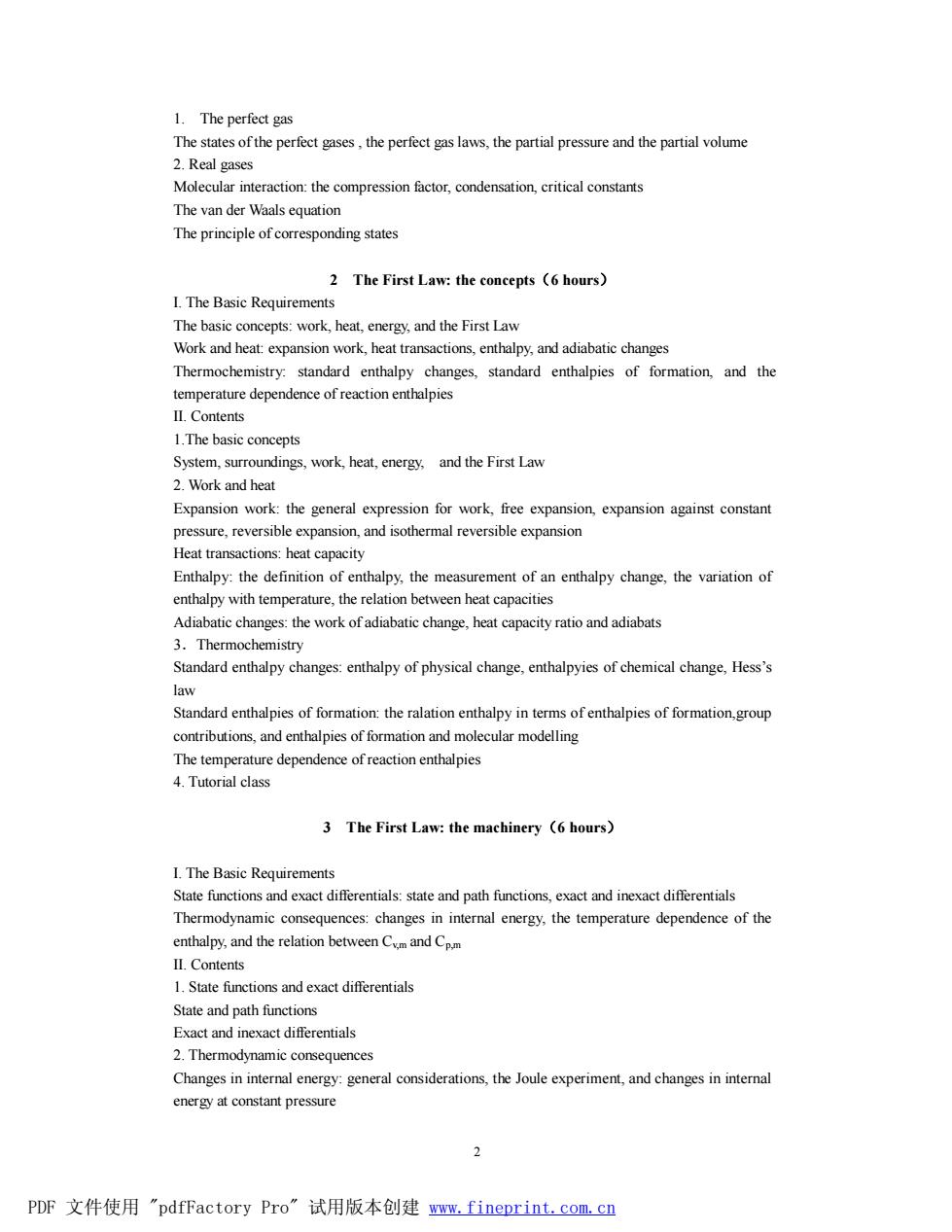
1.The perfect gas The states of the perfect gases,the perfect gas laws,the partial pressure and the partial volum 2.Real gases Molecular interaction:the compression factor,condensation,critical constants The van der Waals equation The principle of corresponding states 2 The First Law:the concepts (6 hours) I.The Basic Requirements The basic concepts:work,heat,energy,and the First Law Work and heat:expansion work.heat transactions.enthalpy.and adiabatic changes Thermochemistry. standard enthalpy changes,standard enthalpies of formation,and the temperature II.Contents 1.The basic concepts System,surroundings,work,heat,energy,and the First Law 2 Work and heat Expansion work:the general expression for work.free expansion expansion against constan pressure,reversible expansion,and isothermal reversible expansion Heat transactions:heat capacity Enthalpy:the definition of enthalpy,the measurement of an enthalpy change,the variation of enthalpy with temperature.the relation between heat capacities Adiabatic changes:the work of adiabatic change heat capacity ratio and adiabats Thermo Standard enthalpy changes:enthalpy of physical change,enthalpyies of chemical change,Hess's law Standard enthalpies of formation:the ralation enthalpy in terms of enthalpies of formation,group contributions,and enthalpies of formation and molecular modelling The temperature 4.Tutorial clas 3 The First Law:the machinery (6 hours) I The basic requirements State fiunction Thermodynamic consequences:changes in internal energy.the temperature dependence of the enthalpy,and the relation between Cmand Cpm II Contents 1.State functions and exact differentials State and path fiunctions Exactand 2.Thermodynamic consequences Changes in internal energy:general considerations,the Joule experiment,and changes in internal energy at constant pressure 2 PDF文件使用"pdfFactory Pro”试用版本创建n,fineprint,com,cn
2 1. The perfect gas The states of the perfect gases , the perfect gas laws, the partial pressure and the partial volume 2. Real gases Molecular interaction: the compression factor, condensation, critical constants The van der Waals equation The principle of corresponding states 2 The First Law: the concepts(6 hours) I. The Basic Requirements The basic concepts: work, heat, energy, and the First Law Work and heat: expansion work, heat transactions, enthalpy, and adiabatic changes Thermochemistry: standard enthalpy changes, standard enthalpies of formation, and the temperature dependence of reaction enthalpies II. Contents 1.The basic concepts System, surroundings, work, heat, energy, and the First Law 2. Work and heat Expansion work: the general expression for work, free expansion, expansion against constant pressure, reversible expansion, and isothermal reversible expansion Heat transactions: heat capacity Enthalpy: the definition of enthalpy, the measurement of an enthalpy change, the variation of enthalpy with temperature, the relation between heat capacities Adiabatic changes: the work of adiabatic change, heat capacity ratio and adiabats 3.Thermochemistry Standard enthalpy changes: enthalpy of physical change, enthalpyies of chemical change, Hess’s law Standard enthalpies of formation: the ralation enthalpy in terms of enthalpies of formation,group contributions, and enthalpies of formation and molecular modelling The temperature dependence of reaction enthalpies 4. Tutorial class 3 The First Law: the machinery(6 hours) I. The Basic Requirements State functions and exact differentials: state and path functions, exact and inexact differentials Thermodynamic consequences: changes in internal energy, the temperature dependence of the enthalpy, and the relation between Cv,m and Cp,m II. Contents 1. State functions and exact differentials State and path functions Exact and inexact differentials 2. Thermodynamic consequences Changes in internal energy: general considerations, the Joule experiment, and changes in internal energy at constant pressure PDF 文件使用 "pdfFactory Pro" 试用版本创建 www.fineprint.com.cn
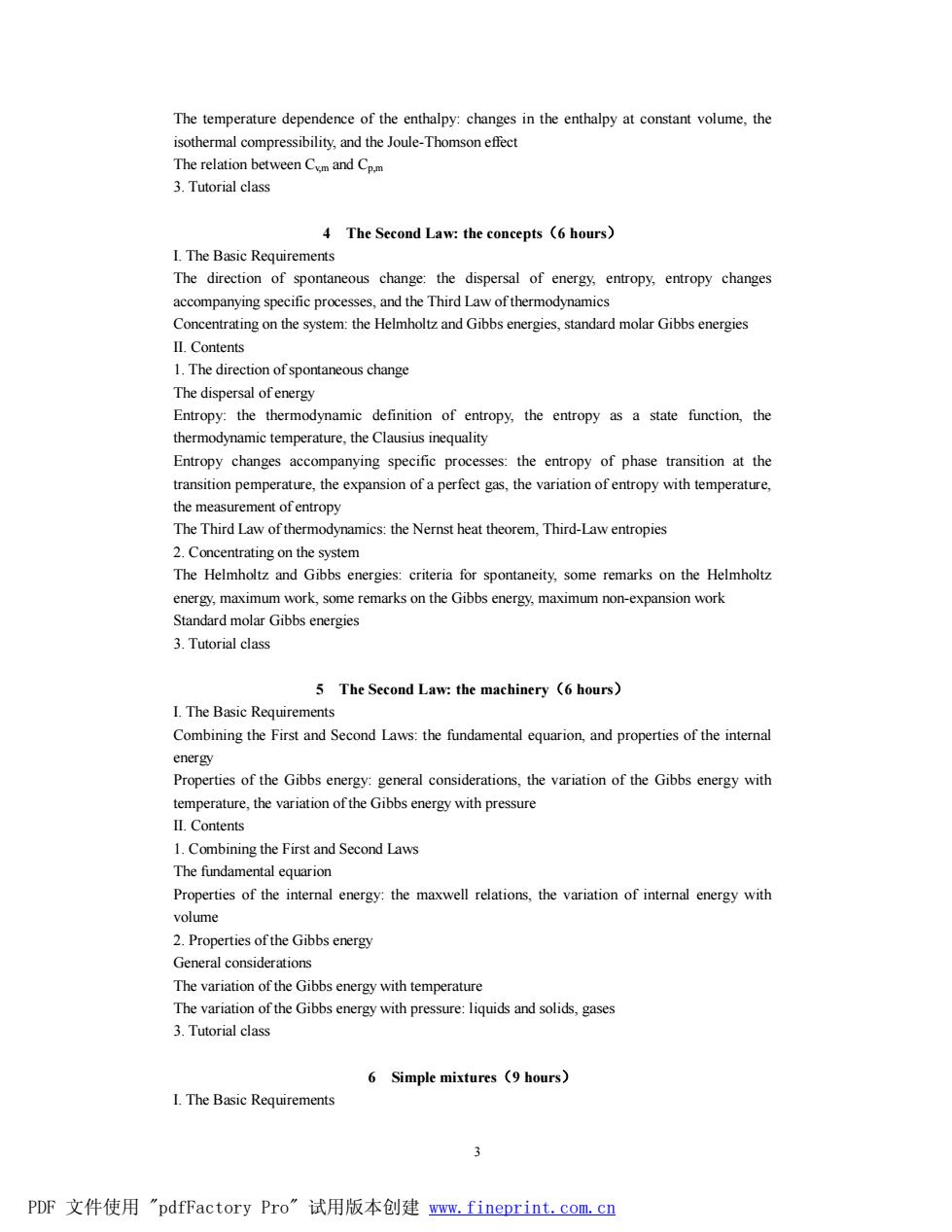
The temperature dependence of the enthalpy:changes in the enthalpy at constant volume,the isothermal compressibility.and the Joule-Thomsoneffec The relation between Cm and Cm 3.Tutorial class 4 The Second Law:the concepts (6 hours) I.The Basic Requirements The direction of spontaneous change:the dispersal of energy,entropy,entropy changes accompanying specific processes,and the Third Law ofthermodynamics Concentrating on the system:the Helmholtz and Gibbs energies,standard molar Gibbs energies IL Contents The dispersal of energy Entropy:the thermodynamic definition of entropy,the entropy as a state function,the thermodynamic temperature.the Clausius inequality Entropy changes accompanying specific processes:the entropy of phase transition at the ransition pemperature,the n of a perfect gas,the variatio of entropy with temperature the mea asurement of entropy The Third Law ofthermodynamics:the Nernst heat theorem,Third-Law entropies 2.Concentrating on the system The Helmholtz and Gibbs energies:criteria for spontaneity,some remarks on the Helmholtz energy.maximum work,some remarks on the Gibbs energy.maximum non-expansion work dard molar Gibbs energie 3.Tutorial clas 5 The Second Law:the machinery (6 hours) I.The Basic Requirements Combining the First and Second Laws:the fundamental equarion,and properties of the interal energy Properties of the Gibbs energy:general considerations,the variation of the Gibbs energy with temperature,the variation of the Gibbs energy with pressure II.Contents 1.Combining the First and Second Laws The fundan Properties of the interal energy:the maxwell relations,the variation of interal energy with volume 2.Properties of the Gibbs energy General considerations The variation of the Gibbs temper ure ofthe Gibbs energy with pressure:liquids and solids,gases 3.Tutorial class 6 Simple mixtures (9 hours) 1.The Basic Requirements 3 PDF文件使用"pdfFactory Pro”试用版本创建ww,fineprint.com,cn
3 The temperature dependence of the enthalpy: changes in the enthalpy at constant volume, the isothermal compressibility, and the Joule-Thomson effect The relation between Cv,m and Cp,m 3. Tutorial class 4 The Second Law: the concepts(6 hours) I. The Basic Requirements The direction of spontaneous change: the dispersal of energy, entropy, entropy changes accompanying specific processes, and the Third Law of thermodynamics Concentrating on the system: the Helmholtz and Gibbs energies, standard molar Gibbs energies II. Contents 1. The direction of spontaneous change The dispersal of energy Entropy: the thermodynamic definition of entropy, the entropy as a state function, the thermodynamic temperature, the Clausius inequality Entropy changes accompanying specific processes: the entropy of phase transition at the transition pemperature, the expansion of a perfect gas, the variation of entropy with temperature, the measurement of entropy The Third Law of thermodynamics: the Nernst heat theorem, Third-Law entropies 2. Concentrating on the system The Helmholtz and Gibbs energies: criteria for spontaneity, some remarks on the Helmholtz energy, maximum work, some remarks on the Gibbs energy, maximum non-expansion work Standard molar Gibbs energies 3. Tutorial class 5 The Second Law: the machinery(6 hours) I. The Basic Requirements Combining the First and Second Laws: the fundamental equarion, and properties of the internal energy Properties of the Gibbs energy: general considerations, the variation of the Gibbs energy with temperature, the variation of the Gibbs energy with pressure II. Contents 1. Combining the First and Second Laws The fundamental equarion Properties of the internal energy: the maxwell relations, the variation of internal energy with volume 2. Properties of the Gibbs energy General considerations The variation of the Gibbs energy with temperature The variation of the Gibbs energy with pressure: liquids and solids, gases 3. Tutorial class 6 Simple mixtures(9 hours) I. The Basic Requirements PDF 文件使用 "pdfFactory Pro" 试用版本创建 www.fineprint.com.cn
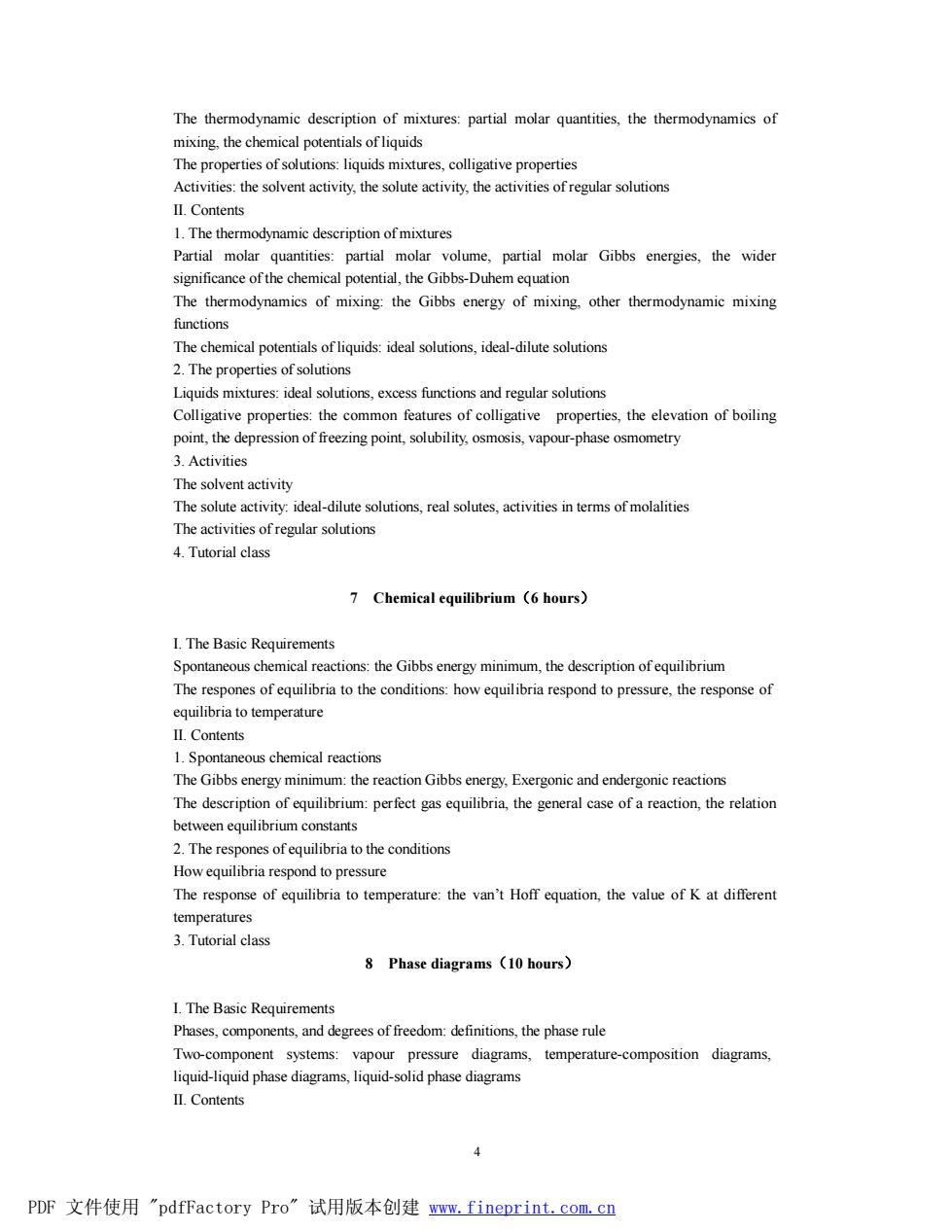
The thermodynamic description of mixtures:partial molar quantities,the thermodynamics of Activities:the solvent activity,the solute activity,the activities of regular solutions II.Contents 1.The thermodynamic description of mixtures partial molar volume,partial molar bb the wider nical entia the Gibbs-Duhemo The thermodynamics of mixing:the Gibbs energy of mixing.other thermodynamic mixing functions The chemical potentials of liquids:ideal solutions,ideal-dilute solutions 2.The properties of solutions Liquidsmitresidcealsolutios,cxcesfrnctosamdregularsoltions properties:thecommo features of,of boiing point,the depression of freezing point,solubility,osmosis,vapour-phase osmometry 3.Activities The solvent activity The solute activity:ideal-dilute solutions,real solutes,activities in terms of molalities 4.Tutorial class 7 Chemical equilibrium (6 hours) 1.The Basic Requirements Spontaneous chemical the Gbbs energy minimum,the description The respones ofequlibria to the conditions:how equilibria respond to pressure,the response of equilibria to temperature II.Contents 1.Spontaneous chemical The Gibbs nergy minimum:the enery Exergonic and endergon The description of equilibrium:perfect gas equilibria,the general case of a reaction,the relation between equilibrium constants 2.The respones ofequilibria to the conditions How equilibria respond to pressure The response of quilibria to temperature:the van't Hoff quation,the value of K at differen 3.Tutorial class 8 Phase diagrams (10 hours) I The basic requirements Phases.degrees of freedm:finitions,the phase rule Two-component systems:vapour pressure diagrams.temperature-composition diagrams. liquid-liquid phase diagrams,liquid-solid phase diagrams II.Contents PDF文件使用"pdfFactory Pro”试用版本创建n,fineprint,com,cn
4 The thermodynamic description of mixtures: partial molar quantities, the thermodynamics of mixing, the chemical potentials of liquids The properties of solutions: liquids mixtures, colligative properties Activities: the solvent activity, the solute activity, the activities of regular solutions II. Contents 1. The thermodynamic description of mixtures Partial molar quantities: partial molar volume, partial molar Gibbs energies, the wider significance of the chemical potential, the Gibbs-Duhem equation The thermodynamics of mixing: the Gibbs energy of mixing, other thermodynamic mixing functions The chemical potentials of liquids: ideal solutions, ideal-dilute solutions 2. The properties of solutions Liquids mixtures: ideal solutions, excess functions and regular solutions Colligative properties: the common features of colligative properties, the elevation of boiling point, the depression of freezing point, solubility, osmosis, vapour-phase osmometry 3. Activities The solvent activity The solute activity: ideal-dilute solutions, real solutes, activities in terms of molalities The activities of regular solutions 4. Tutorial class 7 Chemical equilibrium(6 hours) I. The Basic Requirements Spontaneous chemical reactions: the Gibbs energy minimum, the description of equilibrium The respones of equilibria to the conditions: how equilibria respond to pressure, the response of equilibria to temperature II. Contents 1. Spontaneous chemical reactions The Gibbs energy minimum: the reaction Gibbs energy, Exergonic and endergonic reactions The description of equilibrium: perfect gas equilibria, the general case of a reaction, the relation between equilibrium constants 2. The respones of equilibria to the conditions How equilibria respond to pressure The response of equilibria to temperature: the van’t Hoff equation, the value of K at different temperatures 3. Tutorial class 8 Phase diagrams(10 hours) I. The Basic Requirements Phases, components, and degrees of freedom: definitions, the phase rule Two-component systems: vapour pressure diagrams, temperature-composition diagrams, liquid-liquid phase diagrams, liquid-solid phase diagrams II. Contents PDF 文件使用 "pdfFactory Pro" 试用版本创建 www.fineprint.com.cn
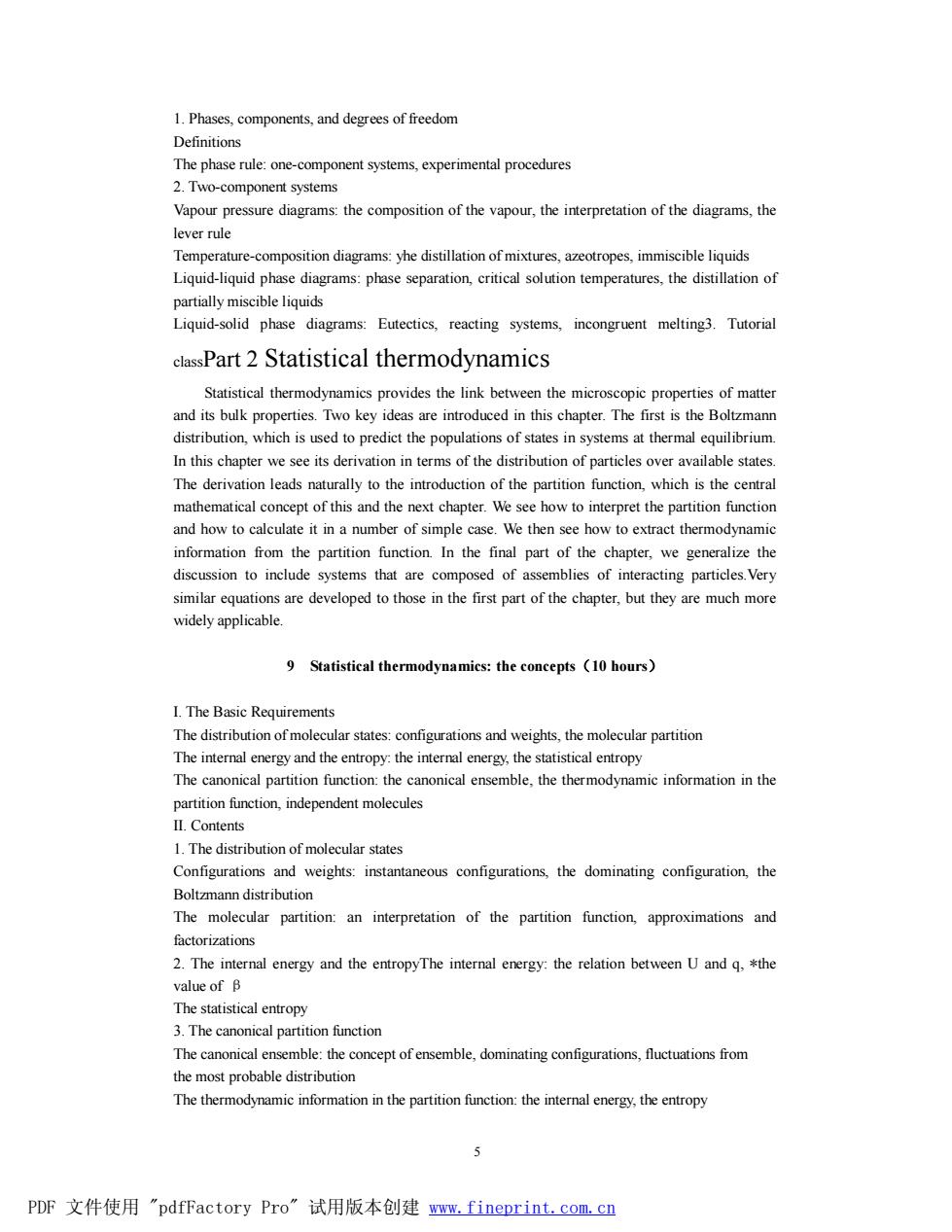
1.Phases,components.and degrees of freedom Definitions The phase rule:one-component systems,experimental procedures 2.Two-component systems Vapour pressure diagrams:the composition of the vapour.the interpretation of the diagrams.the lever rule Liquid-liquid phase diagrams:phase separation,critical solution temperatures,the distillation of partially miscible liquids Liquid-solid phase diagrams:Eutectics,reacting systems,incongruent melting3.Tutorial elassPart 2 Statistical thermodynamics Statistical thermodynamics provides the link between the microscopic properties of matter and its bulk properties.Two key ideas are introduced in this chapter.The first is the Boltzmann distribution,which is used to predict the populations of states in systems at thermal equilibrium. In this chapter we see its derivation in terms of the distribution of particles over available states The erivation leads naturally to the introduction of the parttion which is the ce mathematical concept of this and the next chapter.We see how to interpret the partition fiuncti and how to calculate it in a number of simple case.We then see how to extract thermodynamic information from the partition function.In the final part of the chapter,we generalize the discussion to include systems that are composed of assemblies of interacting particles.Very similar equations are developed to those in the first part of the chapter,but they are much more widelyapplicable. 9 Statistical thermodynamics:the concepts (10 hours) I.The Basic Requirements he st The canonical partition function:the canonical ensemble,the thermodynamic information in the partition function,independent molecules IL Contents 1.The distribution of molecular states and weights: instantaneous configurations,the dominating configuration,the Boltzmann distribution The molecular partition:an interpretation of the partition function,approximations and factorizations 2.The internal energy and the entropyThe internal energy:the relation between U and q,*the value of B 3.The canonical partition function The canonical ensemble:the concept of ensemble.dominating configurations,fluctuations from the most probable distribution The thermodynamic information in the partition function:the internal energy,the entropy PDF文件使用"pdfFactory Pro”试用版本创建ww,fineprint.com,cn
5 1. Phases, components, and degrees of freedom Definitions The phase rule: one-component systems, experimental procedures 2. Two-component systems Vapour pressure diagrams: the composition of the vapour, the interpretation of the diagrams, the lever rule Temperature-composition diagrams: yhe distillation of mixtures, azeotropes, immiscible liquids Liquid-liquid phase diagrams: phase separation, critical solution temperatures, the distillation of partially miscible liquids Liquid-solid phase diagrams: Eutectics, reacting systems, incongruent melting3. Tutorial classPart 2 Statistical thermodynamics Statistical thermodynamics provides the link between the microscopic properties of matter and its bulk properties. Two key ideas are introduced in this chapter. The first is the Boltzmann distribution, which is used to predict the populations of states in systems at thermal equilibrium. In this chapter we see its derivation in terms of the distribution of particles over available states. The derivation leads naturally to the introduction of the partition function, which is the central mathematical concept of this and the next chapter. We see how to interpret the partition function and how to calculate it in a number of simple case. We then see how to extract thermodynamic information from the partition function. In the final part of the chapter, we generalize the discussion to include systems that are composed of assemblies of interacting particles.Very similar equations are developed to those in the first part of the chapter, but they are much more widely applicable. 9 Statistical thermodynamics: the concepts(10 hours) I. The Basic Requirements The distribution of molecular states: configurations and weights, the molecular partition The internal energy and the entropy: the internal energy, the statistical entropy The canonical partition function: the canonical ensemble, the thermodynamic information in the partition function, independent molecules II. Contents 1. The distribution of molecular states Configurations and weights: instantaneous configurations, the dominating configuration, the Boltzmann distribution The molecular partition: an interpretation of the partition function, approximations and factorizations 2. The internal energy and the entropyThe internal energy: the relation between U and q, *the value of β The statistical entropy 3. The canonical partition function The canonical ensemble: the concept of ensemble, dominating configurations, fluctuations from the most probable distribution The thermodynamic information in the partition function: the internal energy, the entropy PDF 文件使用 "pdfFactory Pro" 试用版本创建 www.fineprint.com.cn
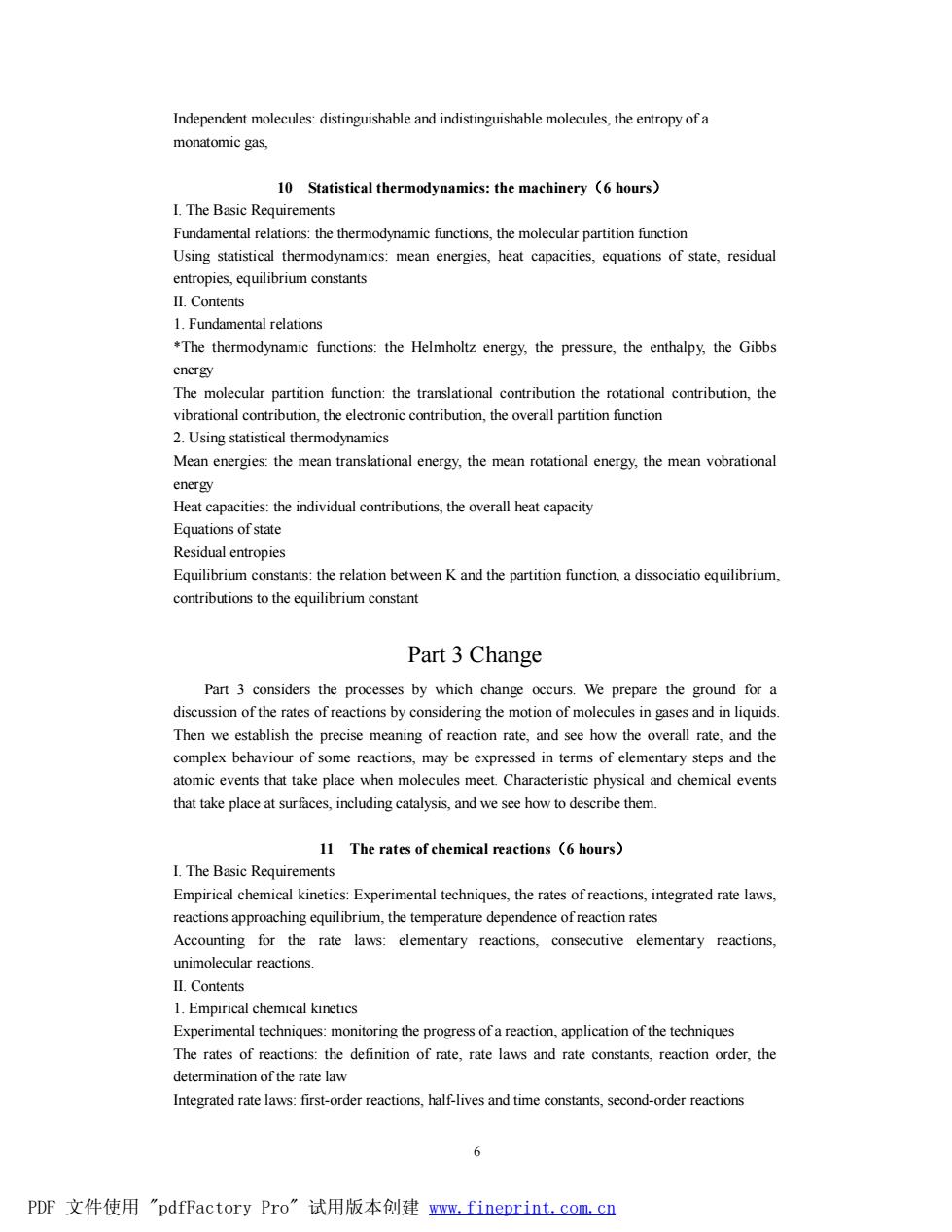
Independent molecules:distinguishable and indistinguishable molecules,the entropy of a monatomic gas 10 Statistical thermodynamics:the machinery (6 hours) 1.The Basic Requirements Fundamental relations:the thermodynamic functions.the molecular partition function Using statistical thermodynamics. mean energies,heat capacities,equations of state,residual entropies.q II.Contents 1.Fundamental relations *The thermodynamic functions:the Helmholtz energy,the pressure,the enthalpy,the Gibbs energy The 2.Using statistical thermodynamics Mean energies:the mean translational energy,the mean rotational energy,the mean vobrational energy Equationsofs Residual entropies Equilibrium constants:the relation between K and the partition function,a dissociatio equilibrium, contributions to the equilibrium constant Part 3 Change Part 3 considers the processes by which change occurs.We prepare the ground for a discussion of the rates of reactions by considering the motion of molecules in gases and in liguids Then we establish the precise meaning of reaction rate.and see how the overall rate.and the nts that take place hen m Characte c physi ical event that take place at surfaces,including catalysis,and we see how to describe them 11 The rates of chemical reactions (6 hours) I The Rasic Requirements imental techniques.the rates ofreactions,integrated rate laws reactions appro Accounting for the rate laws:elementary reactions,consecutive elementary reactions. unimolecular reactions. II Contents 1.Empirical chemical kinetics Experimental te oring the progress ofa of the technique The rates of reactions:the definition of rate,rate laws and rate constants,reaction order,the determination of the rate law Integrated rate laws:first-order reactions,half-lives and time constants,second-order reactions PDF文件使用"pdfFactory Pro”试用版本创建n,fineprint,com,cn
6 Independent molecules: distinguishable and indistinguishable molecules, the entropy of a monatomic gas, 10 Statistical thermodynamics: the machinery(6 hours) I. The Basic Requirements Fundamental relations: the thermodynamic functions, the molecular partition function Using statistical thermodynamics: mean energies, heat capacities, equations of state, residual entropies, equilibrium constants II. Contents 1. Fundamental relations *The thermodynamic functions: the Helmholtz energy, the pressure, the enthalpy, the Gibbs energy The molecular partition function: the translational contribution the rotational contribution, the vibrational contribution, the electronic contribution, the overall partition function 2. Using statistical thermodynamics Mean energies: the mean translational energy, the mean rotational energy, the mean vobrational energy Heat capacities: the individual contributions, the overall heat capacity Equations of state Residual entropies Equilibrium constants: the relation between K and the partition function, a dissociatio equilibrium, contributions to the equilibrium constant Part 3 Change Part 3 considers the processes by which change occurs. We prepare the ground for a discussion of the rates of reactions by considering the motion of molecules in gases and in liquids. Then we establish the precise meaning of reaction rate, and see how the overall rate, and the complex behaviour of some reactions, may be expressed in terms of elementary steps and the atomic events that take place when molecules meet. Characteristic physical and chemical events that take place at surfaces, including catalysis, and we see how to describe them. 11 The rates of chemical reactions(6 hours) I. The Basic Requirements Empirical chemical kinetics: Experimental techniques, the rates of reactions, integrated rate laws, reactions approaching equilibrium, the temperature dependence of reaction rates Accounting for the rate laws: elementary reactions, consecutive elementary reactions, unimolecular reactions. II. Contents 1. Empirical chemical kinetics Experimental techniques: monitoring the progress of a reaction, application of the techniques The rates of reactions: the definition of rate, rate laws and rate constants, reaction order, the determination of the rate law Integrated rate laws: first-order reactions, half-lives and time constants, second-order reactions PDF 文件使用 "pdfFactory Pro" 试用版本创建 www.fineprint.com.cn

The temperature dependence of reaction rates:the Arrhenius parameters,the interpretation of theparameters 2.Accounting for the rate laws Elementary reactions reactions the varation of no with time, step.the steady-state appro on,pre-equilibr riathe kinetic isotope ef Unimolecular reactions:the Lindemann-Hinshelwood mechanism,the activation energy of a composite reaction 3.Tutorial class 12 The kinetics of complex reactions (6hours) I.The Basic Requirements Chain reactions:the rate lawsof chain reactions,explosions Polymerization kinetics:stepwise polymerization,chain polymerization Homogeneous catalysis:features of homogeneous catalysis.enzymes Oscilla in Photochemistry:kinetics of photophysical and photochemical processes,complex photochemica processes II Contents 1 Chain reactions The rate lawsof chain reactions Explosion 2.Polymerization kinetics Stepwise polymerization Chain polymerization Homog Enzyme 4.Oscillating reactions Autocatalysis +Autocatalytic mechanisms ofoscillating reactions Bistability Chemical chao 5.Photochemistry Kinetics of photophysical and photochemical processes:timescales of photophysical processes, the promary quantum yield Complex photochemical pr ses:the overall quantum yield of a photochemical reaction,rate lamwsofcomplexphotochemicalreactiorns,phatosensitizaion 13 The kinetics of complex reactions (4 hours) I.The Basic Requirements Reactive encounters:collision theory,diffusion-controlled reactions,the material-balance > PDF文件使用"pdfFactory Pro”试用版本创建ww,fineprint.com,cn
7 Reactions approaching equilibrium: first-order reactions close to equilibrium, relaxation methods The temperature dependence of reaction rates: the Arrhenius parameters, the interpretation of theparameters 2. Accounting for the rate laws Elementary reactions Consecutive elementary reactions: the variation of concentrations with time, the rate-determining step, the steady-state approximation, pre-equilibria, the kinetic isotope effect Unimolecular reactions: the Lindemann-Hinshelwood mechanism, the activation energy of a composite reaction 3. Tutorial class 12 The kinetics of complex reactions(6 hours) I. The Basic Requirements Chain reactions: the rate lawsof chain reactions, explosions Polymerization kinetics: stepwise polymerization, chain polymerization Homogeneous catalysis: features of homogeneous catalysis, enzymes Oscillating reactions: autocatalysis, autocatalytic mechanisms of oscillating reactions, bistability, chemical chaos Photochemistry: kinetics of photophysical and photochemical processes, complex photochemical processes II. Contents 1. Chain reactions The rate lawsof chain reactions Explosions 2. Polymerization kinetics Stepwise polymerization Chain polymerization 3. Homogeneous catalysis Features of homogeneous catalysis *Enzymes 4. Oscillating reactions Autocatalysis *Autocatalytic mechanisms of oscillating reactions Bistability Chemical chaos 5. Photochemistry Kinetics of photophysical and photochemical processes: timescales of photophysical processes, the promary quantum yield Complex photochemical processes: the overall quantum yield of a photochemical reaction, rate laws of complex photochemical reactions, photosensitization 13 The kinetics of complex reactions(4 hours) I. The Basic Requirements Reactive encounters: collision theory, diffusion-controlled reactions, the material-balance PDF 文件使用 "pdfFactory Pro" 试用版本创建 www.fineprint.com.cn
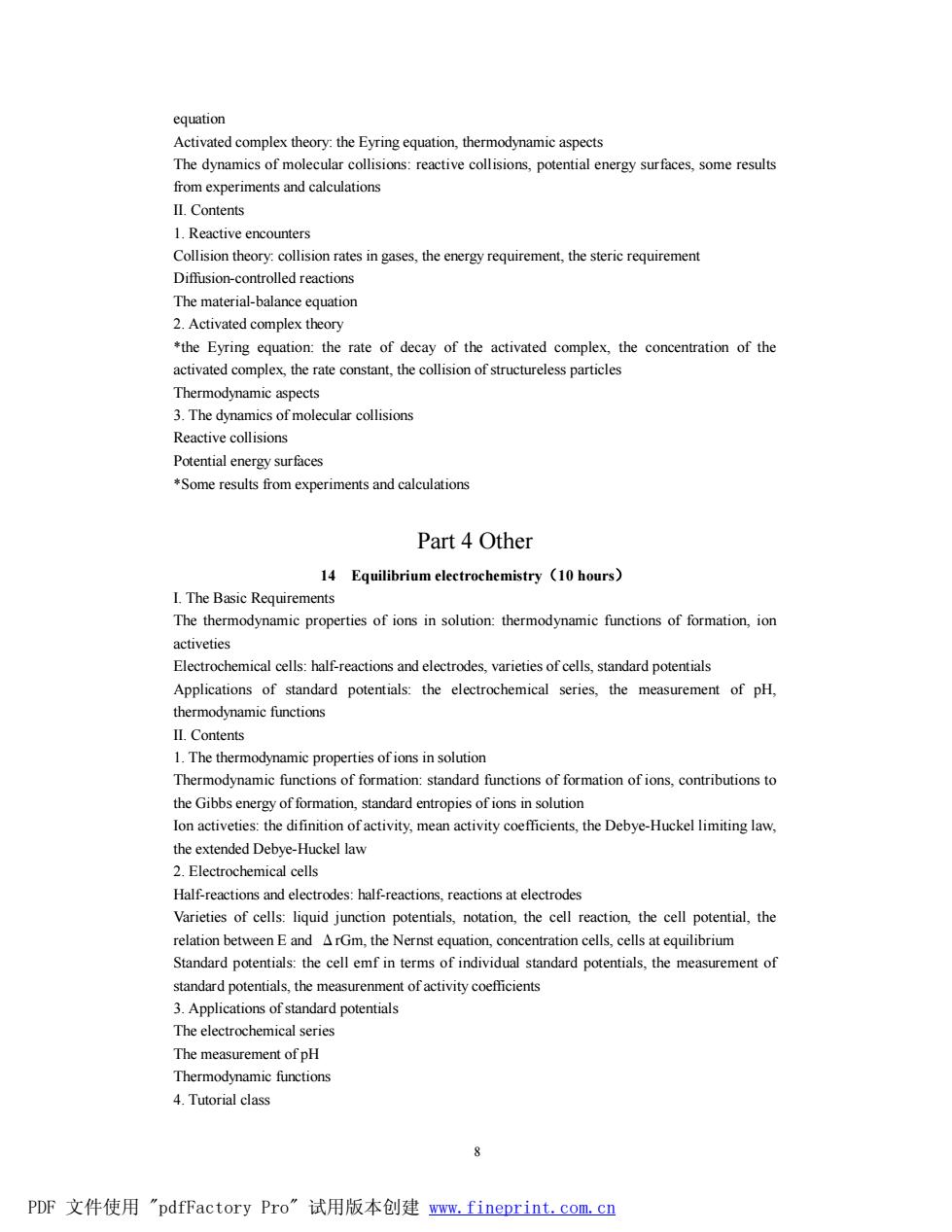
The dynamics of molecuar collisions:reactive collisions,potential energy surfaces,some result from experiments and calculations II.Contents 1.Reactive encounters h然the enrgyqurmnl the一 The material-balance equation 2.Activated complex theory *the Eyring equation:the rate of decay of the activated complex,the concentration of the activated complex the rate constant,the collision of structureless particles Thermodynam ects Reactive collisions Potential energy surfaces *Some results from experiments and calculations Part 4 Other 14 Equilibrium electrochemistry (10 hours) I.The Basic Requirements The thermodynamic properties of ions in solution:thermodynamic functions of formation,ion aiocinaleaeosadoioamsacahodpoi场 Applications of standard potentials:the electrochemical series,the measurement of pH, thermodynamic functions II Contents ropertiesofionsinsoluion The odynamic functio the Gibbs energy,standa rd entropies of ions in solutior lon activeties:the difinition of activity,mean activity coefficients,the Debye-Huckel limiting law. the extended Debye-Huckel law 2.Electrochemical cells and:half-reaction reactions at Varieties of cels:liquid junctio,the the cell potential,the relation between E and ArGm,the Nernst equation,concentration cells,cells at equilibrium Standard potentials:the cell emf in terms of individual standard potentials,the measurement of standard potentials,the measurenment of activity coefficients 3 Applications of standard potentials The electr hemical series The measurement of pH Thermodynamic functions 4.Tutorial class PDF文件使用"pdfFactory Pro”试用版本创建n,fineprint,com,cn
8 equation Activated complex theory: the Eyring equation, thermodynamic aspects The dynamics of molecular collisions: reactive collisions, potential energy surfaces, some results from experiments and calculations II. Contents 1. Reactive encounters Collision theory: collision rates in gases, the energy requirement, the steric requirement Diffusion-controlled reactions The material-balance equation 2. Activated complex theory *the Eyring equation: the rate of decay of the activated complex, the concentration of the activated complex, the rate constant, the collision of structureless particles Thermodynamic aspects 3. The dynamics of molecular collisions Reactive collisions Potential energy surfaces *Some results from experiments and calculations Part 4 Other 14 Equilibrium electrochemistry(10 hours) I. The Basic Requirements The thermodynamic properties of ions in solution: thermodynamic functions of formation, ion activeties Electrochemical cells: half-reactions and electrodes, varieties of cells, standard potentials Applications of standard potentials: the electrochemical series, the measurement of pH, thermodynamic functions II. Contents 1. The thermodynamic properties of ions in solution Thermodynamic functions of formation: standard functions of formation of ions, contributions to the Gibbs energy of formation, standard entropies of ions in solution Ion activeties: the difinition of activity, mean activity coefficients, the Debye-Huckel limiting law, the extended Debye-Huckel law 2. Electrochemical cells Half-reactions and electrodes: half-reactions, reactions at electrodes Varieties of cells: liquid junction potentials, notation, the cell reaction, the cell potential, the relation between E and ΔrGm, the Nernst equation, concentration cells, cells at equilibrium Standard potentials: the cell emf in terms of individual standard potentials, the measurement of standard potentials, the measurenment of activity coefficients 3. Applications of standard potentials The electrochemical series The measurement of pH Thermodynamic functions 4. Tutorial class PDF 文件使用 "pdfFactory Pro" 试用版本创建 www.fineprint.com.cn
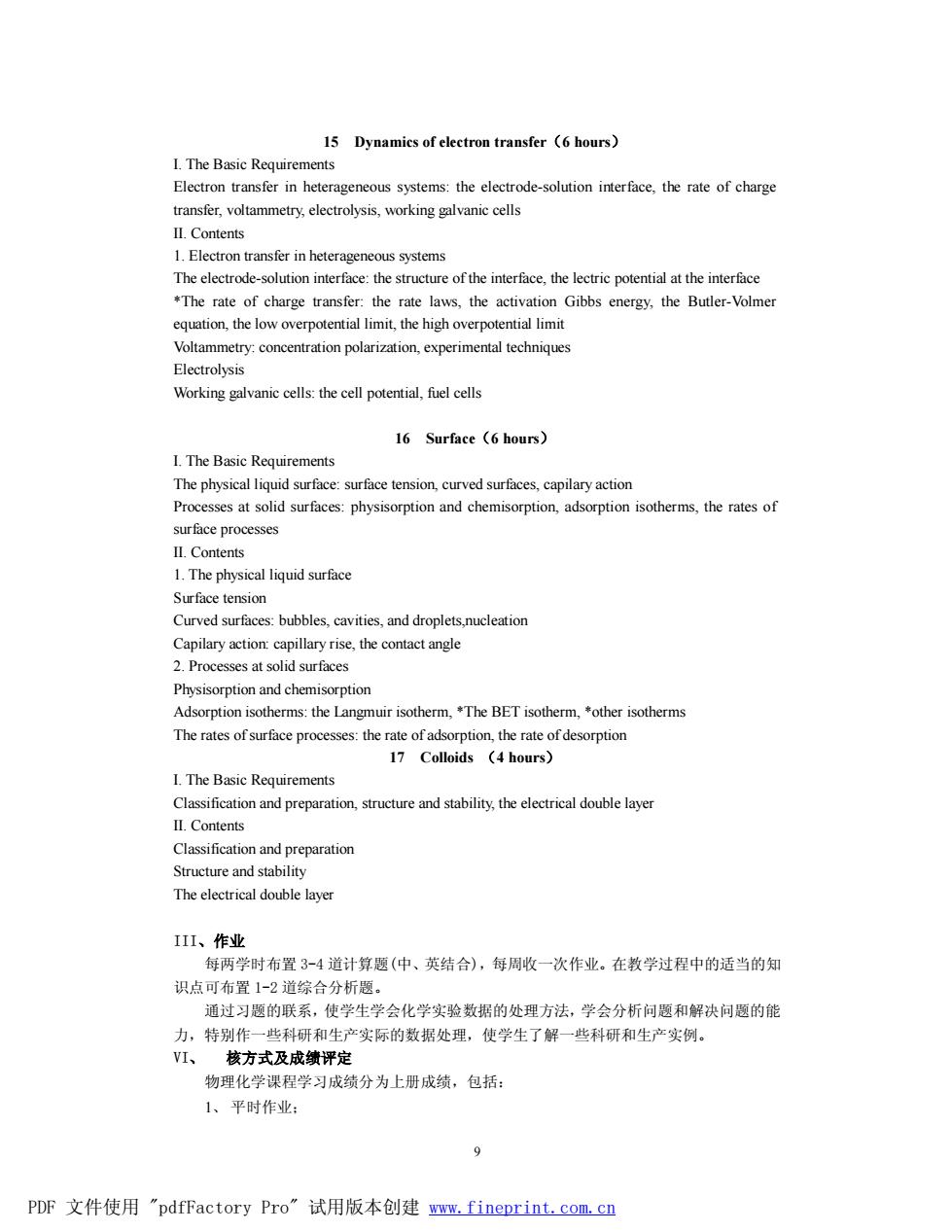
15 Dynamics of electron transfer (6hours) 1.The Basic Requirements Electron transfer in heterageneous systems:the electrode-solution interface,the rate of charge transfer.voltammetry.electrolysis.working galvanic cells II.Contents The electrode-solution interface:the structure of the interface,the lectric potential at the interface The rate of charge transfer:the rate laws,the activation Gibbs energy,the Butler-Volmer equation,the low overpotential limit,the high overpotential limit Voltammetry:techniques Working galvanic cells:the cell potential,fuel cells 16 Surface (6 hours) I.The Basic Requirements rved surfaces,capilary action surface processe II.Contents 1.The physical liquid surface Surface tension Curved surfaces:bubbles,cavities,and capillary rise,the contact angle 2.Processes at solid surfaces Physisorption and chemisorption Adsorption isotherms:the Langmuir isotherm.The BET isotherm,*other isotherms The r tes of surface processes the rate of adsorption,the rate of desorption 17 Colloids (4 hours) I.The Basic Requirements Classification and preparation,structure and stability,the electrical double layer II.Contents and stability The electrical double layer II1、作业 每两学时布置3-4道计算题(中、英结合),每周收一次作业。在教学过程中的适当的知 识点可布置1-2道综合分析题 通过习题的联系,使学生学会化学实验数据的处理方法,学会分析问题和解决问题的能 力,特别作一些科研和生产实际的数据处理,使学生了解一些科研和生产实例。 VI、核方式及成绩评定 物理化学课程学习成绩分为上册成绩,包括 1、平时作业: 0 PDF文件使用"pdfFactory Pro”试用版本创建mw,fineprint,com,cn
9 15 Dynamics of electron transfer(6 hours) I. The Basic Requirements Electron transfer in heterageneous systems: the electrode-solution interface, the rate of charge transfer, voltammetry, electrolysis, working galvanic cells II. Contents 1. Electron transfer in heterageneous systems The electrode-solution interface: the structure of the interface, the lectric potential at the interface *The rate of charge transfer: the rate laws, the activation Gibbs energy, the Butler-Volmer equation, the low overpotential limit, the high overpotential limit Voltammetry: concentration polarization, experimental techniques Electrolysis Working galvanic cells: the cell potential, fuel cells 16 Surface(6 hours) I. The Basic Requirements The physical liquid surface: surface tension, curved surfaces, capilary action Processes at solid surfaces: physisorption and chemisorption, adsorption isotherms, the rates of surface processes II. Contents 1. The physical liquid surface Surface tension Curved surfaces: bubbles, cavities, and droplets,nucleation Capilary action: capillary rise, the contact angle 2. Processes at solid surfaces Physisorption and chemisorption Adsorption isotherms: the Langmuir isotherm, *The BET isotherm, *other isotherms The rates of surface processes: the rate of adsorption, the rate of desorption 17 Colloids (4 hours) I. The Basic Requirements Classification and preparation, structure and stability, the electrical double layer II. Contents Classification and preparation Structure and stability The electrical double layer III、作业 每两学时布置 3-4 道计算题(中、英结合),每周收一次作业。在教学过程中的适当的知 识点可布置 1-2 道综合分析题。 通过习题的联系,使学生学会化学实验数据的处理方法,学会分析问题和解决问题的能 力,特别作一些科研和生产实际的数据处理,使学生了解一些科研和生产实例。 VI、 核方式及成绩评定 物理化学课程学习成绩分为上册成绩,包括: 1、 平时作业; PDF 文件使用 "pdfFactory Pro" 试用版本创建 www.fineprint.com.cn
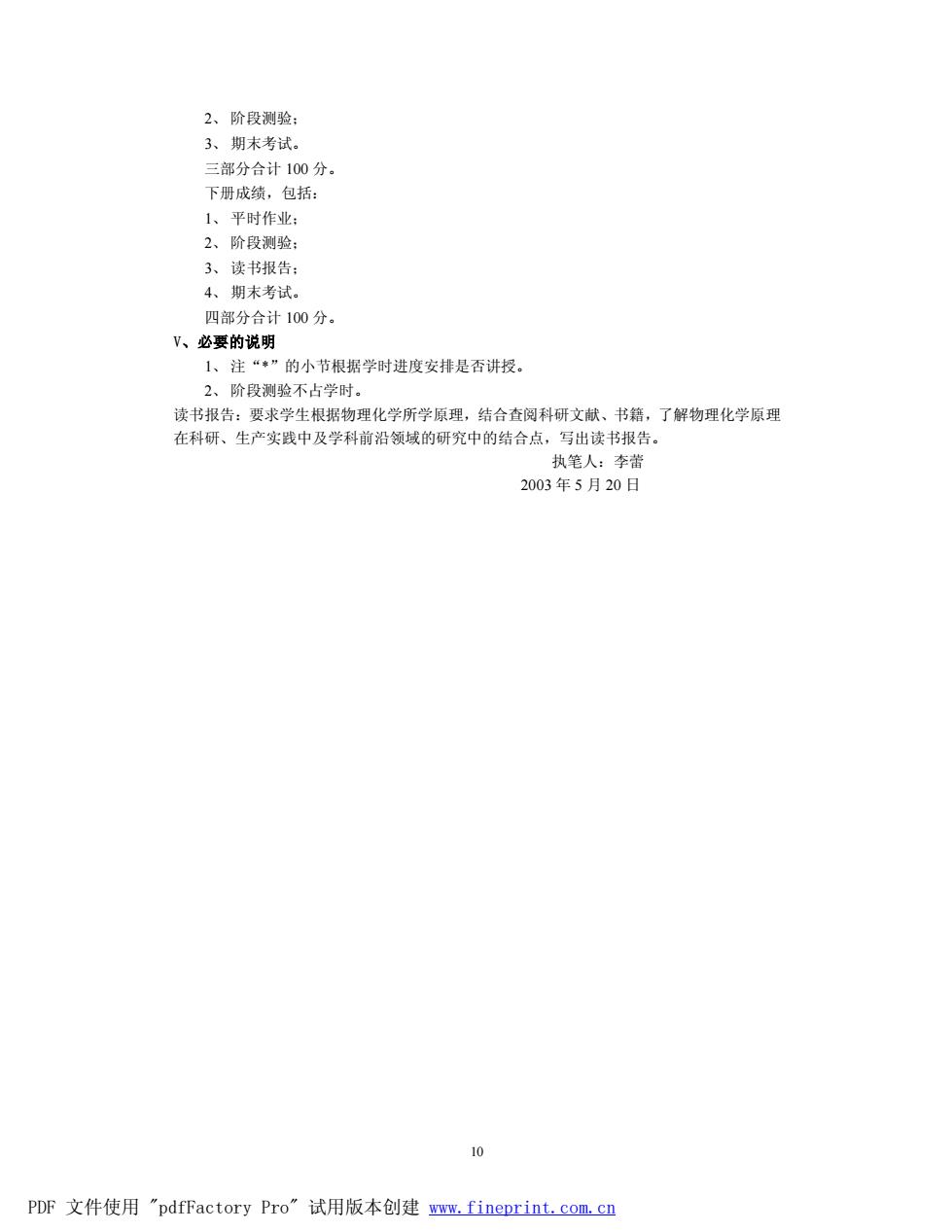
2、阶段测验: 3、期末考试。 三部分合计100分 下册成绩,包括: 1、平时作业: 2、阶段验, 3、读书报告 4、期末考试, 四部分合计100分。 、必要的说明 1、注“◆”的小节根据学时进度安挂是否讲授。 2、阶段测验不占学时。 读书报告:要求学生根据物理化学所学原理,结合查阅科研文献、书籍,了解物理化学原理 在科研、生产实践中及学科前沿领线的研究中的结合点,写出读书报告 执笔人:李苦 2003年5月20日 10 PDF文件使用"pdfFactory Pro”试用版本创建ww,fineprint.com.cn
10 2、 阶段测验; 3、 期末考试。 三部分合计 100 分。 下册成绩,包括: 1、 平时作业; 2、 阶段测验; 3、 读书报告; 4、 期末考试。 四部分合计 100 分。 V、必要的说明 1、 注“*”的小节根据学时进度安排是否讲授。 2、 阶段测验不占学时。 读书报告:要求学生根据物理化学所学原理,结合查阅科研文献、书籍,了解物理化学原理 在科研、生产实践中及学科前沿领域的研究中的结合点,写出读书报告。 执笔人:李蕾 2003 年 5 月 20 日 PDF 文件使用 "pdfFactory Pro" 试用版本创建 www.fineprint.com.cn